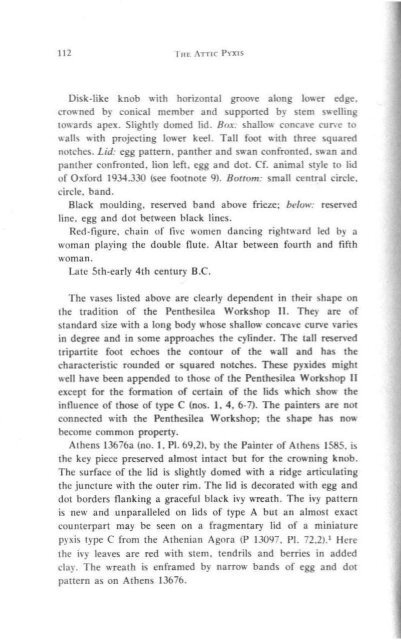Create successful ePaper yourself
Turn your PDF publications into a flip-book with our unique Google optimized e-Paper software.
112 [nr ATTIC PVll:1S SALLY RUTHEJtfliRD ROBEJtn 113<br />
Disk·like knob .....ith horizontal grOO\-C along lo\\,cr edge.<br />
crowned b)' conical member and supponed by stem s.... elling<br />
lowards apex. Slightly domed lid. Box: shalloy. COnC3\"C cunc 10<br />
.... all.. wilh projecting lo.....er keel. Tall foot with three squared<br />
nUlches. Lid: egg pattern. panther and swan confronted. swan and<br />
panther confronted. lion left. egg and dot. cr. animal slyle to lid<br />
of Oxford 1934.330 (see footnole 9). Bottom: small central circle.<br />
circle. band.<br />
Black moulding. reserved band above frieze: bt'ic,JW: reserved<br />
line, egg and dot between black lines.<br />
Red·ligure. chain of Ii\C .... OO1el1 dancing rightward led by a<br />
.....oman playing [he double nute. Altar between fourth and fifth<br />
.....oman.<br />
Late 5th·early 4th century 8.C.<br />
The vases listed above are clearly dependent in their shape on<br />
the tradition of the Penthesilea Workshop 11. They are of<br />
Slandard size with a long body wh~ shallow concave curve \'aries<br />
in degree and in some approaches the cylinder, The lall resen'cd<br />
Iripartite foot echoes the contour of the wall and has the<br />
characteristic rounded or squared notches. These pyxides might<br />
y,ell ha\'e been appended to those of the Penthesilea Workshop 11<br />
except for the formation of ~nain of the lids which show the<br />
influence of t~ of type C (nos. I. 4, 6-7). The painters are not<br />
connected with the Penthesilea Workshop: the shape has now<br />
become common property.<br />
Athens 13676a (no. t. PI. 69,2), by the Painler of Alhens 1585, is<br />
the key piece preserved almost intact but for the crowning knob.<br />
The surface of the lid is slightly domed with a ridge articulating<br />
the juncture with the outer rim, The lid is decorated with egg and<br />
dot borders flanking a graceful black ivy wreath. The ivy pattern<br />
is new and unparalleled on lids of type A but an almost exact<br />
counterpart may be seen on a fragmentary lid of a miniature<br />
p)Xis t}pe C from the Athenian Agora (P 13097. 1'1. 72.2).1 Here<br />
the h'y leaves are red with stem. tendrils and berries in added<br />
day. The wreath is enframed by narrow bands of egg and dol<br />
pallern as on Athens 1.3676.<br />
The foot profile is distincthe, its conca\'e cun"e being<br />
interrupted by a step below the apex. Athens 1585 and Ceramicus<br />
OIS 89) hne an identical foot profile. This is a variant on the<br />
usual profile of the Penthcsilea Workshop occurring earlier on<br />
Athens Agura P 24253 (Fig. Se) by the Veii Painter' and also on<br />
Cambridge 4.1943 by the Curtius Painter. J<br />
The shape of Athens 13676a is mirrored by that of Athens 1585<br />
tno. 2. PI. 69.1 and Fig. lib). the name-piece of the painter. The:'<br />
lid unfortunately is missing but the measurements as well as the<br />
prolilt.~ are very close. The egg and dot border below the frieze is<br />
identical. It seems eenain that the same potter produced both<br />
~asc~,<br />
SUlllcwhal earlier than tht.'Se is a pyxis in the Ceramicus (no. 3.<br />
Fig. lie) found with a hydrill attributed to the eariy work of the<br />
Meidias Painter. a pair of lebetes gamikoi by the Washing<br />
Painter. a patterned pyxis type B and other \'ases in an offering<br />
tr~neh dated 10 the years around 420 B.C.~ The concave cun'e of<br />
the y, ails is more pronounttd than in nos. I and 2 and resembles<br />
more closely Ihat of LOIn're LP 2692 (PI. 42). from the Penthesilea<br />
Wurhhup 11. The disk knob on a high slender stem whose base is<br />
dirrcr~ntiated from the Ic\'el of the lid is familiar in a number of<br />
examples from the Pcnthesilea Workshop (PIs. 22 and 2(».s The<br />
lout profile is like that of nos. I and 2. The cuntour of the side of<br />
the lid is unusual and 1 have yet to find a c1O!1oe parallel among<br />
pyxides of types A and C: that of the fragmentary double PYXls.<br />
Athens Agora P 16924 (PI. 75.2) and also the fragmentary pyxis lid.<br />
type C. P 96.' 3re somewhat similar.<br />
London E 780 (no. 4. PI. 70) and Cambridge 168 (no. S, PI. 72.3)<br />
arc ascribed to the Painter of Florence 4217 who is also known to<br />
ha~e decurated a few pyxides of type B.' The lid of the Cambridge<br />
pp:is has a disk knob on a tall slender stem which blends into the<br />
sloping surface of the lid. characteristics typical uf mediocre work<br />
uf the Pcnthesilea Workshop. The lid of no. 4 resembles that of 110.<br />
I (Athens 13676a. PI. 69.2), There was a central knob (now broken<br />
ay,ay). and then a slightly domed section separated from the outer<br />
rim by a ridge-the two latter features borrowed from lids of type<br />
C. The contour of the side of the lid does not continue the line of

















